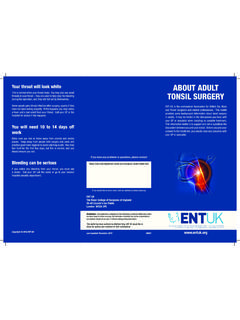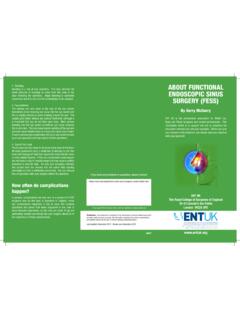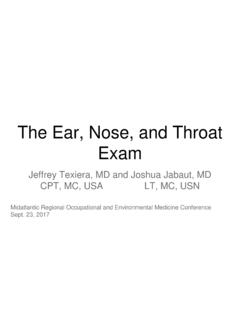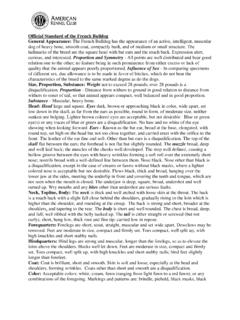Transcription of Ear Nose and Throat: The Official Handbook for Medical ...
1 Students and Foundation Trainees in Otolaryngology (SFO UK). SFO UK. ENT UK t/a BACO & BAO-HNS. Royal College of Surgeons 35-43 Lincoln's Inn Field London WC2A 3PE. +442074058371. Ear, nose and throat : The Official Handbook for Medical Students and Junior Doctors By the Students and Foundation Doctors in Otolaryngology (SFO. UK). Part of ENT UK. Authors and Editors Alexander Yao Michaella Cameron Charlotte McIntyre John Allen Mamoona Khalid-Raja Jayesh Doshi Andrew Robson Dheeraj Karamchandani Roland Hettige Eamon Shamil Irfan Syed Nimesh Patel Contents Introduction Preface Foreword A Career in Ear, nose and throat Surgery Further Information Generic Skills in ENT. General ENT History Ear Examination Nasal Examination Neck and thyroid status exam Cranial Nerve Examination Otology Ear Anatomy Dizziness and Vertigo Hearing Loss Tinnitus Facial Nerve Palsy Otalgia Otorrhoea Otitis Externa Acute Otitis Media Otitis Media with Effusion Chronic Otitis Media Cholesteatoma Rhinology Nasal Function and Anatomy Epistaxis Nasal obstruction Fractured nose Septoplasty/Septorhinoplasty Rhinitis and Rhinosinusitis Allergic Rhinitis Non-Allergic Rhinitis Acute Rhinosinusitis Chronic Rhinosinusitis Nasal Polyps Other Sinonasal Lesions Cleft Lip and Palate Head and Neck Head and Neck Anatomy Facial Muscles Blood Supply to the Face and Neck The Major Salivary Glands Oral Cavity Topography of the Neck Fascial Layers of the Neck Nervous Supply of the Head and Neck Physiology of Swallowing Taking History of a Neck Lump Causes of Neck Lump Branchial Cysts Dysphagia Dysphonia Tonsillitis Pharyngeal Pouch Globus Pharyngeus Thyroid Masses
2 Thyroglossal cyst or sinus Multinodular goitre Thyroid cancer Benign and Malignant Neoplasms of the Salivary Glands Carcinoma of the Oral Cavity Carcinoma of the Pharynx Carcinoma of the Nasopharynx Carcinoma of the Oropharynx Carcinoma of the Hypopharynx Carcinoma of the Larynx Laryngopharygeal reflux Snoring and Obstructive Sleep Apnoea ENT Emergencies Acute Airways Obstruction Epistaxis ( nose Bleed). Foreign body in the nose Nasal septum haematoma Foreign body in the ear Perforated tympanic membrane FB in the pharynx or oesophagus Deep neck space infections Penetrating neck trauma Medications in ENT. Antibiotics Steroids Antihistamines Vestibular sedatives & Meniere's disease Practical Procedures in ENT. Nasal Cautery Anterior Nasal Packing Nasendoscopy Oto-Microscopy and Foreign Body Removal ENT Investigations Pure Tone Audiometry Audiogram Case Study 1. Audiogram Case Study 2. Tympanometry Hearing Tests In Children ENT Operations Grommet Insertion Middle ear and Mastoid surgery Tonsillectomy Adenoidectomy Functional Endoscopic Sinus Surgery Parotidectomy Thyroidectomy Neck Dissection Tracheostomy Introduction Preface ENT makes up a significant part of the clinical practice of general practitioners, paediatricians and emergency doctors although exposure to the specialty is often limited during undergraduate training.
3 This E-book has been written to provide a practical guide to the day-to-day management of common ENT conditions and will be helpful to Medical students and junior doctors as well as other clinicians that have exposure to ENT as part of their practice. It has been developed by the Students and Foundation Doctors in Otolaryngology group (SFO UK), which is part of ENTUK. The group aims to provide support for undergraduates in medicine and junior doctors with an interest in ENT. The content is based on a Delphi study that set out what the most important topics should be in an undergraduate ENT curriculum taking in to consideration guidance published in Tomorrow's Doctors by the General Medical Council guidance. Congratulations to the authors and to my colleagues on the SFO UK. committee for delivering an excellent and novel educational resource. A number of individuals have been instrumental in producing this E-book from conception to production. These include Alex Yao, Michaella Cameron, Charlotte McIntyre, John Lee Allen and Mamoona Khalid-Raja.
4 I also wish to particularly thank the section editors Andrew Robson, Dheeraj Karamchandani, Roland Hettige, Eamon Shamil, Nimesh Patel & Irfan Syed as well as James Tysome & Victoria Ward (Elf-ENT) for allowing us to use many of their images. Mr Jayesh Doshi PhD FRCS (ORL-HNS) MMed Consultant Otolaryngologist Chairman of SFO UK committee (2018). Foreword Ear, nose , and throat (ENT), or otorhinolaryngology, is an important, interesting and diverse specialty. It covers a wide range of areas from the common, such as tonsillitis, to the highly specialised, including cochlea implantation, congenital airway disease, voice disorders, skull base and facial plastic surgery. Whether you become a GP or an A&E doctor, you will encounter ENT pathologies in abundance, some of which can be life threatening. Yet, students have limited exposure to the specialty within most undergraduate curricula. This book complements the national ENT curriculum written by ENTUK. Although not designed to be a comprehensive text, this book aims to provide you with the most important topics that you should know by the time you finish Medical school and qualify as a foundation doctor.
5 The book will also prove useful for foundation doctors wishing to refresh and review their ENT knowledge. Topics are presented systematically in an easy-to-read format suitable for short attachments. Students may also find it useful to use as reference material chapters explaining common medicines, investigations, procedures, and operations specific to ENT. ENT is a very hands-on specialty and ENT doctors are generally very approachable! So make the most of every opportunity to exude enthusiasm, watch and participate during your attachment! Professor Anthony Narula Consultant Otolaryngologist MA MB BChir FRCS FRCS (Ed). President of ENTUK (2016). A Career in Ear, nose and throat Surgery ear nose and throat (ENT) surgery or Otorhinolaryngology offers an exciting and varied surgical career option. It has been described as a cradle to grave' specialty with a caseload ranging from a baby with hearing loss, teenager with allergic rhinitis to an elderly man with throat cancer.
6 As there is no separate Medical companion, ENT. surgeons also manage the non-surgical care of their patients. Furthermore, once at registrar level, on calls can be done from home, which can be considered as particularly attractive. Subspecialties Head and Neck Surgery Otology Skull Base Surgery/Neuro-Otology Thyroid and Parathyroid Surgery Rhinology Facial Plastic Surgery Paediatrics Laryngology Typical working week 4 clinics a week 2 surgical sessions a week Light emergency work Multidisciplinary work with other specialties (audiology, speech and language therapist, endocrinologist, oncologists, plastic surgeons, maxillofacial surgeons and dermatologists). Further Information Approach your local ENT team! ENT UK: Student and Foundation Trainees in Otolaryngology (SFO UK): Association of Otolaryngologist in Training (AOT) : Royal College of Surgeons of England: British Association of Paediatric Otolaryngology (BAPO): British Rhinological Society (BRS) : British Otolaryngology & Allied Sciences Research Society (BOARS) Intercollegiate MRCS exams: Generic Skills in ENT.
7 General ENT History Principles of history taking in ENT. Good history taking is an essential skill to be maintained throughout your training. By building a good rapport, you will help the patient feel more comfortable about discussing his/her symptoms. It provides the opportunity to explore a patient's concerns and expectations. After completing a thorough history, you should have a good idea of what the top differential diagnoses could be. Before starting Wash your hands Introduce yourself and ensure the patient is comfortable Maintain good eye contact and remember the importance of developing good rapport with the patient (and the parents if present). Structure of history taking Presenting complaint (PC) How may I help you today?'. History of presenting complaint (HPC) When did this problem begin'. Enquire about the relevant risk factors and other specific questions relating to the presenting complaint. Do have a targeted list of questions for PCs related to Ear , nose , and throat /Head Neck (For targeted histories, go to the relevant sub sections of this booklet).
8 Previous episodes - Severity, response to previous treatment and hospitalisation Past Medical history (PMH). Birth History Particularly important for ear conditions in children Drug history (DH) - Including over the counter medication and vaccinations Allergies Family History Social history (SH) - Do not forget to enquire about the impact that the presenting complaint has had on quality of life Systems review - Also enquire on any tendency to bruise or bleed easily At the end of the history Summarise the patient's history to them. Clarify that you understood them correctly and whether there is anything else that they would like to mention. Ear examination Before starting Gel/wash your hands Introduce yourself and ensure the patient is comfortable Ask about any pain or tenderness The patient should be positioned on the chair and you should place yourself to the side of the patient. In children, positioning is even more important. Children should be sat across the parent/nurses lap, with the side of the head held to the chest by the carer's hand (See Figure 1) Flailing arms can be secured with the carer's other hand.
9 Ideally, aim to examine children as opportunistically as possible and incorporate play as part of the examination. Figure 1: Correct positioning of a child for ear exam Inspection From the front: note the size, assess symmetry of the pinna. Are there differing degrees of protrusion? Is there an obviously abnormal pinna? For example, see Figure 2. Figure 2: Congenital Microtia of the External Auditory Canal Inspect each ear individually - Start with the normal ear Pre-auricular - Inspect for scars (previous parotidectomy or middle ear surgery), swelling (infection, parotid tumour), erythema (infection/ inflammation), sinuses, pits, fistulae Pinna - Note any signs of erythema, swelling (infection, haematoma) or tenderness Post-auricular - Move pinna anteriorly to inspect behind the pinna. Note any post-auricular scars. Acute and/ or painful swelling here suggests infection (mastoiditis or lymphadenitis). Examine the other ear. Note any difference. Otoscopy Ensure the otoscope has good magnification and illumination.
10 Use the largest speculum that will fit comfortable in the external auditory canal (EAC). Start with the normal ear Gently pull the pinna upwards and backwards to straighten the ear canal to best visualise the tympanic membrane. In children, pulling the pinna downwards and backwards may provide better visualisation Hold the otoscope like a pencil and use your little finger as a fulcrum against the cheek to avoid injury should the patient move suddenly Inspect systematically Figure 3: Normal right tympanic membrane External auditory canal: Wax or discharge, erythema, swelling (infection, trauma). Tympanic membrane (See Figure 3): Is there a normal light reflex in the anteroinferior quadrant? Colour of drum - Normal is greyish & translucent. Pink/red colouring can mean infection/inflammation and white plaques can indicate tympanosclerosis. Position of drum - Retracted (cholesteatoma, infection), bulging (infection), perforation Ossicles: The malleus, incus and stapes can be seen sometimes through the tympanic membrane especially if there is a perforation.








